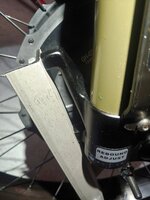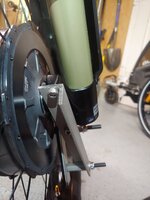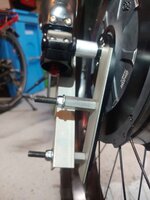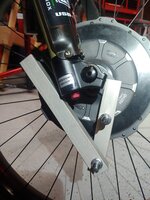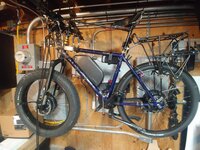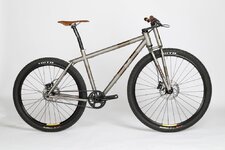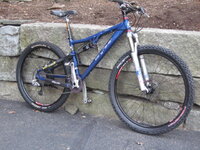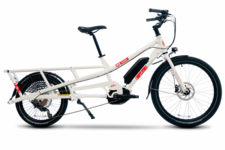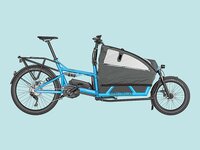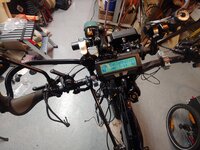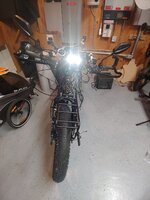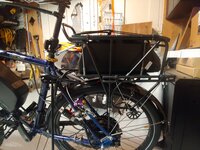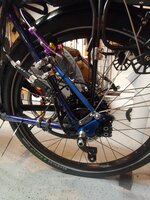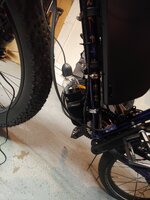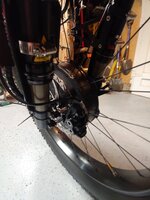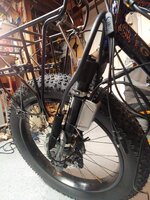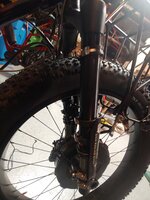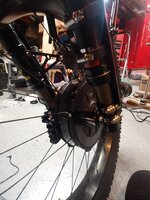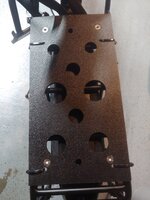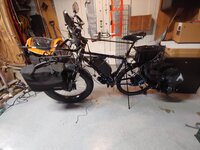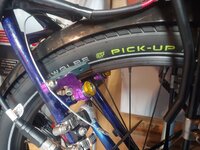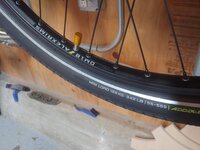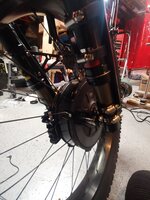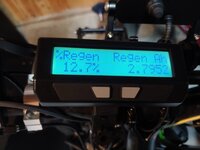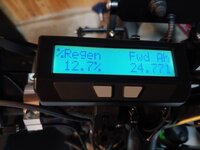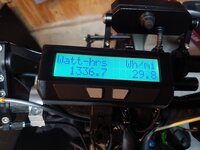Alright, as promised, here's a final raft of photos now that this bad boy is finally complete... mostly. I'd say it's about 95% finished, but the remaining tasks are mostly polish and refinement: Things like a righthand mirror, thief-proofing the hose clamps for the downtube battery with transparent PVC and pipe clamps, fitting a temporary fat bike front fender because the metal one I ordered from Germany is lost in shipping hell, et cetera. The unfortunate thing just now is that the spouse has a migraine so although I just tightened up the build, I can't test ride until tomorrow

. Probably won't post much more about it unless people have specific questions. I might post a bit more once I get some miles on it and see what it can do. Having already tested it in full-throttle-hang-on-for-dear-life mode, I know it's going to kick ass at it's job of hauling lots of stuff as a bike semi with my Surly trailer. We may also try to do some local touring with it, since it can carry 5 panniers plus whatever we can fit on both racks, and also since it turns out to be very versatile in terms of efficiency. It has a potentiometer tied to the maximum power output, in addition to the usual assist levels (using the 5 default levels, can be easily re-programmed to another number), and the 3 aforementioned presets. The presets also allow me to switch between legal and not-so-legal configurations in a matter of seconds.
I will be very interested to see what kinds of torque readings I see out of the logger on hill climbs, as well as what the top speed will be when adding human power into the mix. I've had brief moments of buyer's remorse when reading about and watching videos of crazy HPC kits and 2000W+ factory e-bikes like the Monarch AWD (not legally registered mopeds, so technically illegal to operate on roads). However, after my throttle-only test rides and the spill I took, not to mention watching more of those videos, those doubts have been erased. Even people testing 50+ MPH e-bikes, like Electrek, admit that those speeds are insane, and they only achieved them to find the limits of the bike; in almost every case, as soon as someone hits those speeds, they wisely back down to something more reasonable like 25 or 30. Moreover, those bikes have really terrible range if you intend to hot rod them around--they are, in fact, referred to as 'hot-rodded' e-bikes. And despite their massive power, the bike I built actually manages to have more torque than just about anything on the road, more in line with a small car. This is because I chose the slow-wind version of both motors, which have more torque, and because of the high-range cassette (really hope to get that 11th gear working some day). So while it's fast compared to 99% of the e-bikes on the road, it's actually slow compared to what it would be with faster windings. Within that lower speed limit, though, it has crazy torque, as two failed torque arms can attest, so the acceleration up to that limit is pretty intense. You can get up to a max speed of about 30 MPH in a couple of seconds on flat ground. There is a light near my house where the problem on my existing bikes is people getting annoyed because they are stuck behind you and passing unsafely. On my first or second test run I noticed I no longer have that problem due to Bruce's acceleration, but funnily enough a new problem cropped up: Namely that once in the protected bike lane on the other side of the light, the car in the lane to my left sped up to 50 to beat me to the next light so they could cut me off from the sharrows lane and bike lane past that light. The extra 10 MPH is a substantial change though, so I'll probably ride with elbow and knee guards on this bike. I've had a few spills on e-bikes now (all 13 MPH or slower!) and I'm kind of tired of cheese-grater elbows and knees.
So I'm pretty satisfied at the moment; time will tell if I stay that way, but having built the whole thing, I'm confident I can repair, or re-engineer and replace, anything that goes wrong. It will probably take a while to get the hang of riding it. For now I'm looking forward to being able to haul heaver loads up hills, pass indecisive/slow drivers that I currently am too slow to pass on the R&M, and pull away from annoying cyclist traffic during heavy traffic. The latter consists mostly of unassisted cyclists leap-frogging me at lights and then riding much slower than my top speed, forcing me to take the lane to pass.
Oh, and one other detail that is great is that both motors have geared clutches so they have always-on brake regen. On my most recent 4 mile round trip, I regenerated about 13% of the power I used, which is pretty amazing for regen on an e-bike.
The most salient points in this mostly final build are:
- RMA'ed the defective front fork and fitted the new one, which in addition to not being defective, is a better fork (different/newer generation)

- Finished v3 of a torque arm solution for the front motor with M8 hardware, locking Fuji nuts (commonly used on motorcycles), orange threadlock (3x stronger than blue), and 1/8" stainless steel plate and angle iron
- Replaced the death trap front tire, which was a Surly Knard 26"x4.8", with an Origin8 Supercell 26"x4.0" which has siping for wet conditions, better road traction, and lower rolling resistance; and also added Tannus armor and Stan's No Flat
- Rebuilt the rear battery deck out of 1/8" stainless steel plate, as the marine board version sagged and deformed under the weight and tension; also theft-proofed the hanging hardware a bit by replacing it with case hardened linear motion rods, and attaching them with red threadlock at the bottom plate
- Shortened the cables going to and from the rear controller, which is housed in the rear battery mount, which cleans things up in the back quite a bit; probably removed 6 feet of cable
- Rigged up a more stable/useful set up for the lefthand mirror
- Finally got the correct bottom bracket and fitted it (ordered directly from China via Aliexpress as Grin has a 3 month delay on the part), so I was finally able to fit the chain and tune the drive train
Mostly final cockpit view and comparison next to the R&M:
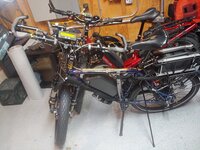
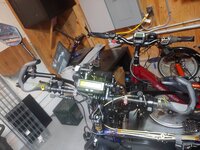
The new tire in close-up and compared to the Schwalbe Super Moto-X's on our R&M Homage. It's still a huge tire, but looks tiny to me compared to the Surly Knard. It does take 2 inches off the height, but the downtube angle is still good. The length from the saddle to the pedal and the handlebar height are identical to what I'm used to on the R&M:
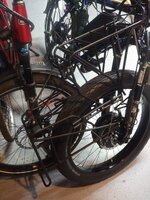
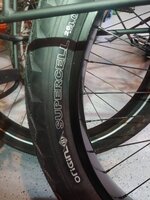
A chain! Tuning has been a bit of a bear: Cannot get the 11th gear in the rear into the tune, I might have to take it to the LBS and see if they can get it working. I tightened the cable as much as I can and shortened the chain as much as I dare, but can't get the rear derailleur into a low/outside enough position to shift into that gear. The mechanism still has enough play to get there, though.
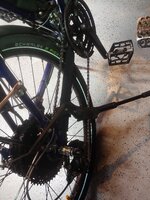
Details views of cable management and an additional pair of Surly rack stays I added near the bottom of the rack to stabilize it; on my wipe out on a test ride of the earlier iteration, I found that the rack sagged down onto the rear fender, causing it to rub the rear tire. After fixing that issue, I had to replace and re-cut the rear fender stays as well to get it back off the tire:
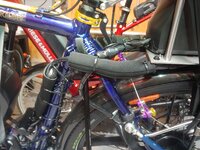
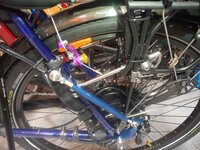
Top and side views of the new battery deck. Everything is countersunk to be nice and low profile and the stainless steel is very stiff so there is no flexing whatsoever now. As mentioned, I also replaced the vertical struts, or whatever you want to call them, with case hardened stainless steel linear motion rods of the kind usually used in industrial printing applications. They were a bit pricey at almost $50 a pop, but between those, Hexlock inserts I intend to add to a couple of the top bolts, red threadlock on the bottom bolts and another plate in the back (1/4" aluminum), my nearly $1000 rear battery is safe and secure on the bike (not perfectly, but enough to leave it locked up outside for a few hours in a visible area):
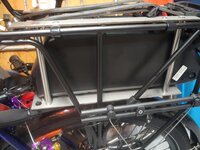
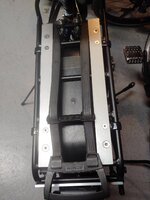
Different views of front torque arm V3 (also, a functioning fork!). The other nice thing about the new fork is that it is the proper racing version designed for dual front brake rotors, so I was able to mount my custom torque arm extension directly into the post mounts for the righthand brake rather than into a Grin frame clamp secured with hose clamps:
